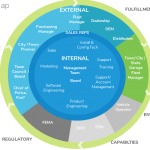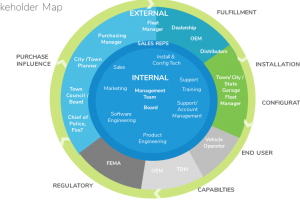1. Separate Your Test Subjects
Focus groups are a nearly comical mode of user research. Comical if it weren’t for the waste of money. If you gather twelve or so people in a room and ask questions, those who are used to speaking up, do–those who are used to keeping their ideas to themselves in a group, do. You’re simply formalizing this pattern for a cost in a sterile conference room with bad sandwiches. If you want to understand how users use a system, ask them to perform common tasks and watch them, unaided and uninterrupted.
If you want to get varied and valuable opinions from each of your test subjects, separate them when asking questions. The last thing you want for research is group think, or coercion of a stronger personality, management structure or office politics over one of your contributors. You can complete separate testing or interviews 1:1 or, via remote interview.
You can also get this separate perspective by using the almighty sticky note as a way for each individual to answer questions. In this way everyone contributes, and everyone hears and can respond to different and new ideas.
2. Never Ask Them About “The System”
“How do you like the system?”
“What do you think of the app?”
These types of questions are very common in user research. The answers are also common–and predictable. “It’s great.” “Um, I like it?” The questions point the interviewee directly into the current app or software, not into how they use it, what they need it to do, how it does or doesn’t meet their overall needs.
User testing uncovers a nasty reality–we lie. You and I and everyone we know lies. It’s not meant to cause harm, in fact we do it without even knowing. When asked about how we perform tasks we give the pleasing, correct, best possible answer–we’re all so good!
Invariably this isn’t how users actually behave or use a system. They aren’t trying to evade answers or corrupt the test, but trying to help. If you’ve asked about the system, users are going to tell you only about the system and if they like you, the company that developed the system, possibly their job–how much they like the software, app or system.
Conversely if you ask questions like “How would you improve the software?” you are going to get a litany of issues to fix small features, but may not solve overall needs because you have cut that larger viewpoint out of the conversation.
Business Offerings and Software
In a B2B software world, the people you are interviewing are intelligent and likely quite good at their job. They are better at their job than they are good at whatever app or product gets tossed to them to improve their work on a pretty regular (average four year) timeframe. As such, you want to find out how they do their job, what they need, how they prefer to work, what organization system they use for their work, how they organize their time, what frustrates them and anything else you can around reaching their goals.
Some questions that will get B2B users talking about their work process:
- Ask them to tell you about their mornings. What’s the first thing they do after they get coffee and start working in the morning?
- How do they keep track of their customers? What about when they leave the office? Whatever the answer is, ask them to show you. (This is where so many secret spreadsheets have been identified.)
- Is there anything that tends to wake them up / keep them awake at night about work?
- Ask about their goals for the quarter or year that have been given to them by management. How will they reach them? What’s making it difficult or getting in the way?”
Consumer Offerings and Software
With a B2C offering, customers will often give positive answers if they have a positive view of the company as a whole or if you are a nice interviewer. Sometimes they are more positive because they are compensated for their interview and thus want to give positive feedback. It’s not intentional, but impacts your research greatly.
For B2C research, you want to find out their other habits, likes, preferences and behaviors. You’ll likely want to know about their shopping habits and social use, how they spend their time.
- How they organize their time, and what’s frustrating about getting everything done in limited time.
- What devices do they use from day to day?
- What they do in person as much as what they do online.
- You’ll want to know how their family needs, money, convenience, social perception and time might influence their behavior.
3. No, Client Stakeholders Cannot Represent the Users
So far, in working with over one hundred and fifty companies, I’ve yet to hear, “Yes, we really want you to talk to our users.” Each and every time someone offers to take the place of users, to “give you all the information you need.” Every. Single. Time.
It’s not their fault. Company teams work diligently to understand their users, and really do a great job in so many cases. However, no matter how hard they try, internal teams still have an internal perspective. Sharing information across teams does not get you closer to understanding users, but to understanding peers’ understanding of users. How is this solved? Make a strong commitment, there is no way around it–user research must include actual users, and as many as possible.
Some common challenges:
- If you have HIPAA, PHI, financial or other privacy issues, there are options to ensure anonymous answers and reporting.
- Sometimes companies don’t know their users, not everyone has built a large email list. This is where social media tools can be used to ask if people will contribute to a study or take a survey or questionnaire.
- Not having time for user research should not be a viable reason to exclude it. User research cuts the cost and waste in projects dramatically over each project lifecycle and longer term.
- If the brand or product is one of interest to an average person, show up in an average place, on the street, outside a popular store and ask if people would be willing to answer a couple of questions. In these scenarios its recommended the answers are brand generic.
4. Glad to Hear “User Research is Already Done”
User research is often seen as something to get out of the way and once done should not be undertaken as a task again–why waste money? Well get ready for your client / manager / company to grab onto their wallets because user research is never, never done. That doesn’t mean there has to be an enormous, focused project where everything stops and everyone waits for some large findings report.
User research is like taking an ongoing temperature of your company’s product. Imagine only tracking company sales every other year or more. User research is just as important as sales numbers. Understanding what your customer and potential customer base want, expect, and are frustrated by, has an important impact on your bottom line. Being able to adjust before negative impacts hit your sales cycle is vital. User research can uncover those issues and trends.
Of course you want to review existing user research, see what was asked, how, in what mode, and what channel. It may be the research questions were great, but just need to be asked again, and on multiple channels to get different perspectives.
- What user base contributed to research?
- Are you capturing the true user base or is the information swayed by who was available?
- Is the research dated because new products, processes, or brand aspects have been introduced?
- Having existing research is an advantage because it helps you round out the next set of research and build an ongoing plan.
Ongoing research may include everything from digital tracking to ongoing monthly surveys with different user bases, social surveys, polls and questionnaires, periodic user testing of newly released and/or upcoming features. It may also include quick ratings at the end of each service center call or chat session.
User Research Is Vital
The goal of user research is a frequent and deep understanding of your user base. This information uncovers issues, informs new project needs, and most positively, may uncover phenomenal opportunities for growth and new offerings.
- Let your users talk and then interpret their input into the design you do so well
- Limit assumptions of what users want
- Be cautious of cutting out user input because there is no time or no money for “that”
- Review what you are asking of users, and in what channel to what audience to ensure you are getting the full picture










